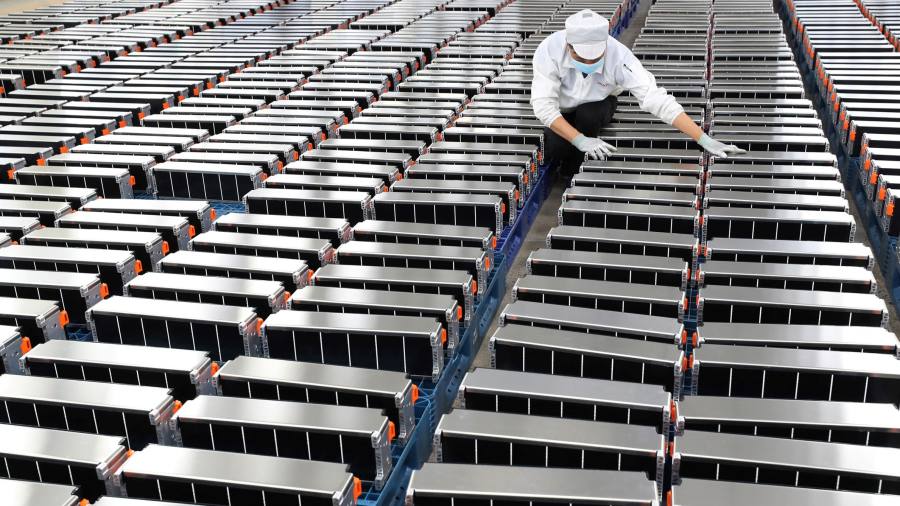Receive free Commodities updates
We’ll send you a myFT Daily Digest email rounding up the latest Commodities news every morning.
Hello from London, where we are heading into a bumper week of company results.
But before those come out — we are expecting Shell and TotalEnergies on Thursday, among many others — Chevron has jumped the gun with an announcement late on Sunday that its chief executive Mike Wirth would stay in place beyond the company’s mandatory retirement age. You can read Myles McCormick’s story on that here.
In Energy Source this week, we take a look at the upcoming shortage of metals needed for the energy transition — and how much the supply-demand gap could be alleviated by recycling.
We also look at the latest news out of Beijing, and whether the muted economic recovery there will cast a shadow over China’s oil demand this year.
Thanks for reading. — Leslie Hook
Why the energy transition could hinge on . . . recycling
There’s plenty of hand-wringing over how a shortage of metals could pose a risk to the energy transition. All those transmission lines, wind turbines and electric car batteries will require a lot of copper, nickel and lithium — far more than is produced today. Or so goes the common orthodoxy.
However a report from the Energy Transitions Commission shines a fresh light on this issue, and presents some radical projections for how this supply-demand gap for metals could be reduced — by recycling and using material more effectively.
Take lithium: by 2030 demand for the metal is expected to soar six-fold from current production levels. At that point, lithium demand will be 30 per cent higher than projected supply, in a base-case scenario.
With extensive recycling and using less lithium in future batteries, that gap could narrow to just 10 per cent — which the report dubs the “maximum efficiency” scenario.
Lord Adair Turner, chair of the commission, said demand for these metals would respond quickly to market signals. “These things move rapidly,” he said. “Even imperfect markets do induce responses.”
The impact of recycling battery metals would grow over time, he added, as opportunities to recycle batteries increase. “Recycling out to 2030 can, by definition, only play a relatively small role, because there are only so many [electric vehicles] . . . by 2040 it can make a huge difference.”
The trend is even more pronounced for copper and nickel. By 2030, copper demand will outstrip supply by 10 per cent in a base-case scenario. But that gap could reverse if recycling and copper substitution are very high — potentially leading to a slight surplus in copper supply by 2030, according to the projections in the report.
For nickel, an aggressive shift towards battery chemistries that use less nickel, along with increased recycling, could also lead to a surplus in 2030, it finds.
Even so, the report’s authors acknowledge the energy transition will still require a vast number of new mines. As many as 40 copper, 55 nickel and 65 lithium mines could be required by 2030, according to the report. Increased recycling and efficiency would reduce the number of additional mines needed.
But even with a great expansion in metals recycling, new mines will still be needed.
Data Drill
On Monday evening, a closely watched meeting of the Politburo issued its verdict on China’s economic recovery after the coronavirus pandemic: “tortuous”.
While this didn’t come as a huge surprise after China’s second-quarter gross domestic product growth was much lower than expected, the pronouncement is worrying for those who were banking on a stronger recovery.
A crucial question is how the sluggish economy will affect Chinese oil demand. So far this year, demand has raced ahead of economic growth, and rose to an all-time high in April.
Much of this appears to be linked to physical demand, as people start driving and flying again after the pandemic lockdowns last year. Sinopec, China’s largest seller of gasoline and jet fuel, reported that oil product sales were up 28 per cent during the second quarter of 2023, compared to the previous year.
“The recovery is going very slowly, and yet the oil demand data has been incredibly strong,” said Neil Beveridge, senior analyst at Bernstein in Hong Kong.
But will that continue into the second half of this year? A lot is riding on the answer: China is expected to account for 70 per cent of total global oil demand growth this year, according to the International Energy Agency.
The IEA expects that global oil markets will tighten in the second half of 2023, and it expects Chinese oil demand to continue at more than 16.3mn barrels per day — hovering near April’s record highs.
But with the gloomy readout from Monday’s Politburo meeting, that projection may soon start to look a bit too rosy.
Power Points
Energy Source is written and edited by the FT’s global energy team. Reach us at [email protected] and follow us on Twitter at @FTEnergy. Catch up on past editions of the newsletter here.
Read the full article here



